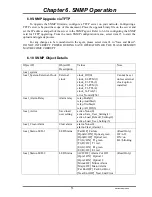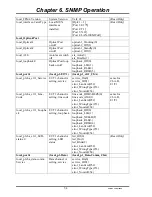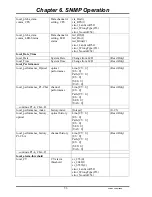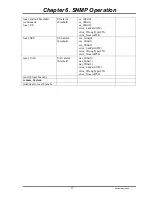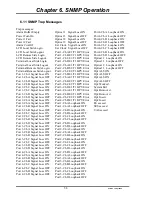
Chapter 6. SNMP Operation
51
Version 1.2 Apr 2006
Press "9" to enter the SNMP Card Configuration menu.
LOCAL
<<< SNMP Card Config >>>
1. SNMP Agent Config
2. Manager Config
3. TFTP and Flash
4. Save and Restart
Please select the item or <ESC> to previous menu.
Under item 1, "SNMP Agent Config", the parameters for the local SNMP agent (the internal
SNMP card) can be configured. This includes the IP address, subnet mask, and gateway for the card
as well as the IP address and server path to the TFTP server for upgrade purposes.
Press "1" to enter the SNMP agent configuration menu.
LOCAL
<<< SNMP Agent Config >>>
1. IP Address [ 0. 0. 0. 0]
2. Subnet Mask [ 0. 0. 0. 0]
3. Gateway IP [ 0. 0. 0. 0]
4. TFTP Server IP [ 0. 0. 0. 0]
5. TFTP Server Path [ ]
Please select the item or <ESC> to previous menu.
Item number 1
, IP address is the IP address that the SNMP card will answer to when "pinged",
Telnet'd, TFTP'd or when accessed by SNMP.
Item number 2
, is the subnet mask for the network that the card is attached to.
Item number 3
, is the default gateway for the network that the card is attached to and is required if
the Fiber Multiplexer is to be managed from a different subnet.
Item number 4
, is the IP address of a server running the TFTP protocol (trivial FTP) used for
updating the SNMP firmware image in the SNMP card.
Item number 5
, is the path and filename of the image file that the SNMP card will download when
the TFTP upgrade function is called.
After setting, exit the Agent configuration menu with <ESC> and the save the settings by
selecting item "4" from the SNMP Card Config menu or continue to Manager Config.
HINT:
when entering IP addresses, enter without "dots" and include any leading zeros. For
example, the above IP address 172.24.1.11 would be entered as 172024001011 while 10.0.0.1
would be entered as 010000000001.
Remember, when setting the "server path" information for a UNIX or LINUX based server,
the upper and lower case must be correctly observed. Also remember that UNIX path separators use
"/" while Windows uses "\" to separate path directories.

















